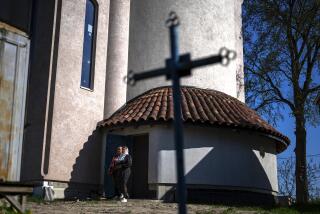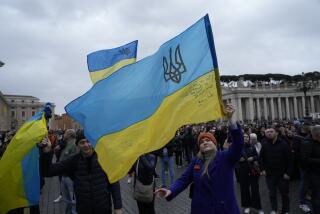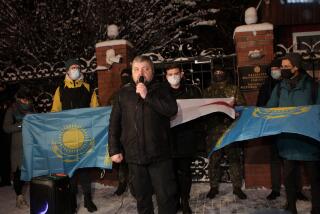Half a Century Later, Ukraine Priest Goes Home : Religion: War and communism kept him out of his homeland. Now he returns to a church that has survived decades of suppression.
- Share via
VATICAN CITY — One clear autumn day in 1938, a newly ordained priest named Myroslav Lubachivsky rode a bus to the train station in the Ukrainian city of Lvov and there, two valises firmly in hand, embarked on a journey west that would last more than half a century.
“I thought I would be gone three years to complete my doctorate--five at most,” Lubachivsky recalled this week.
Events intervened: war, murder, mass deportations, decades of repression in a tortured land, all of it endured at long distance by a Ukrainian patriot whose odyssey-in-exile seemed unending.
It ends today. Lubachivsky returns to Lvov for the first time in 52 years, 33 of them spent in the United States as a pastor and teacher who often also drove his students’ bus to school.
Myroslav Lubachivsky is 77 now, a slender, cleareyed and self-effacing individual with a white brush beard and an ornate cross slung from his neck on a thick gold chain.
He is a cardinal, Major Archbishop of Lvov, a city he scarcely remembers, and patriarch of the small and stubborn Ukrainian Catholic Church, which does not celebrate its resurrection this Easter only because it refused to die.
Lubachivsky goes home again this morning on a chartered Soviet jet from Rome as a powerful symbol of change in the Ukraine and as fruit of an astonishing underdogs’ victory: The secret church he has led from exile survived 45 years of official proscription and unflagging police suppression.
For decades, underground priests, when they were not in jail or Siberia, led clandestine services for frightened but determined worshipers.
“For a full liturgy, people went to the fields or forest,” Lubachivsky said. “They held services in private homes, trembling, never sure whether the KGB was listening.”
Today in the Ukrainian republic, it is not only newly permissible but also popular again to be assertively Ukrainian--and in Lvov, where the mayor dreams of an independent Ukraine, to be a practicing Catholic.
What that augurs, in the present Soviet flux, is as uncertain as Lubachivsky’s own role in his rediscovered homeland.
“What will my job be? What can I do there?” he mused amid a flutter of movers at his apartment in Rome as he prepared to leave. “I have always worked hard. Is my hard work being rewarded now? I don’t know.”
As he returns to the restive, Texas-size breadbasket of the Soviet Union, where around 5 million people--about 10% of the population--are Catholics, Lubachivsky in a sense embodies the tumultuous 20th-Century history of both his republic and his church.
When he was born in 1914 in the small town of Dolyna near Lvov in the western Ukraine, it was an outpost of the Austro-Hungarian Empire. When he was ordained in 1938 in Lvov, the Ukraine belonged to Poland, and it was a punishable offense to speak Ukrainian in the street. As Lubachivsky studied in Austria in 1939, Josef Stalin seized the Ukraine and made it part of the Soviet Union.
Then Nazi Germany invaded, and after the war communism returned with a vengeance. In 1946, Stalin officially dissolved the Ukrainian Catholic Church and declared it absorbed within the Moscow-obedient Russian Orthodox Church, which had broken with Rome in the 11th Century.
Lubachivsky could not go home. In 1947, he went to the United States to join a Ukrainian church that now has 210 parishes and around 150,000 members. He worked with Ukrainian refugees in Connecticut and at Ukrainian parishes in Michigan, Pennsylvania and Wisconsin.
“I was always too busy to have much longing for home,” he said.
For 17 years he worked at Sts. Peter and Paul Ukrainian church and school in Cleveland, as preacher and teacher. “At first we had only a station wagon, but later we got a real school bus for me to drive,” he said. One of the organizers of today’s reception in Lvov is a woman who was once Lubachivsky’s student in Cleveland.
He went to teach at the Ukrainian seminary in Washington and remembers driving like a madman, church to church through the Virginia countryside, as simultaneous pastor of Ukrainian churches in Manassas and Richmond. He then taught in Philadelphia and Connecticut, and in 1979 was named Ukrainian metropolitan archbishop of Philadelphia by Pope John Paul II. Lubachivsky will leave his American passport at home today to travel on a Vatican document, but if he takes the wheel in the Ukraine, he will drive on his Pennsylvania license.
Being a bishop was good, Lubachivsky says, because it gave him his first real chance to travel through the United States. And it was bad because there were a lot of ceremonial demands on someone accustomed to being a working priest, and he never seemed to stop.
“My young staff could never remember that I am not a spring chicken. . . . Three or four events a day and then a banquet at which many stupidities were spoken and I was expected to speak as well. I told jokes--people remember jokes better than sermons,” he said with a smile.
On the death of Cardinal Josyf Slipyj in 1984, Lubachivsky became archbishop of Lvov, with headquarters in exile at the Vatican. And there, with the Cold War still raging, he seemed likely to stay. Slipyj, Lubachivsky’s predecessor, spent 18 years in Soviet prison and labor camps. He was one of the lucky ones.
Stalin began arresting Catholic bishops in the Ukraine in 1945. In 1947 one was murdered. By the 1950s, two bishops had died in prison, two in labor camps and two shortly after completing their sentences, paralleling the fate of more than 1,500 arrested priests and tens of thousands of Ukrainian Catholics transported east to Siberia.
Ukrainian Catholics clung to their religion in what John Paul would call “a catacomb church,” in which new priests were ordained and bishops consecrated in secret services. The clandestine priests led one life in Soviet society and a second in their church. The Vatican did not know who some of the bishops were.
“We are a simple people, and perhaps we are stubborn. But after 45 years of real persecution, I call the survival of the church a miracle of God,” Lubachivsky said.
When John Paul met 10 bishops from the Ukraine last year, he discovered that one went to work every day as a medical orderly, one as a collective farm laborer, one as a fish smoker and one as a professor of physics.
Repression eased under Soviet President Mikhail S. Gorbachev, but as recently as 1989 a Ukrainian priest was drafted into the army for six months as punishment for publicly celebrating Mass.
Amid increasing agitation and assertiveness by Ukrainian Catholics demanding legalization of their religion, Gorbachev’s historic meeting here with the Pope on Dec. 1, 1989, effectively marked the end of official attempts to kill what would not die. The Communists should have known better than to try, Lubachivsky says: “The Romans tried for centuries to destroy religion and ended up destroying themselves.”
There are many pieces to fit back together as Lubachivsky heads home, including roiled relations with the Russian Orthodox Church, which is being obliged to return churches and other properties it inherited from the Catholics following the official proscription in 1946.
Time enough to deal with the problems when in Lvov, he says.
“It is still not a reality, so I can’t think so much about it. First, it has to be a reality.”
Amid frantic packing one afternoon in Rome last week, a beaming staff member brought the cardinal his visa to go home, 52 years later. Lubachivsky looked at it for a long time. “I am numb,” he said.
More to Read
Sign up for Essential California
The most important California stories and recommendations in your inbox every morning.
You may occasionally receive promotional content from the Los Angeles Times.










